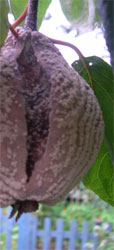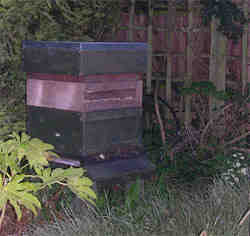Quince Jelly recipe (also works with Japonica quinces)
Posted by Fiona Nevile in Jam Jelly and Preserves | 163 comments Our friend Bunty gave us a Portuguese quince tree three years ago. Besides being very decorative, with dark branches and lazy, floppy leaves it produces the large firm fruit that make the tastiest jelly. Mature quince jelly (over six months old) turns a gorgeous amber colour.
Our friend Bunty gave us a Portuguese quince tree three years ago. Besides being very decorative, with dark branches and lazy, floppy leaves it produces the large firm fruit that make the tastiest jelly. Mature quince jelly (over six months old) turns a gorgeous amber colour.
The first year our tree produced one small quince. It bore three last year and this year suddenly came into its own. The crop would be at least ten. The fruit are quite big so there would be enough to make more than jelly. Anne Mary and I poured over her old recipe books. We could make quince marmalade or try our hand at Membrillo. Greedily I watched the quinces mature and fatten. Imagine my horror when I noticed that the fruit was splitting and rotting on the tree. The cause, I discovered, was lack of water.
It’s easy to forget trees in a drought. Especially when they have done well in their first couple of years. Old established trees have much deeper roots and can find water more easily than younger, smaller trees. It would have been so easy to take a spur from the drip watering system in the kitchen garden to the quince tree. I just didn’t think.
Our poor pear harvest was probably due to lack of water. I am going to give both trees a dressing of rich compost from our composter and cosset them this winter. Hopefully the bees will boost the germination of the blossom next spring. Our bees arrived just as the blossom was going over this year.
I managed to harvest two half quinces and they are simmering on the stove as I write this. The aroma from the simmering quinces is richly fruity. We’ll be lucky to make a couple of small jars. One for Anne Mary and one for us, as an inspiration for next year.
Quince Jelly recipe (this works well with Japonica quinces too)
Ingredients:
- 2 lbs of quinces
- 1 lemon (just the juice, sieved)
- white granulated sugar
- water to cover
Method:
- Wash and roughly chop the quinces (no need to peel, decore or depip) and place in a heavy bottomed saucepan.
- Barely cover with water. Bring to the boil and simmer gently with a lid on until soft. If the quinces are very firm this could take several hours. Check it every now and then and add more water if necessary.
- Pour the cooked fruit through sterilised muslin into a large clean bucket or bowl (how do I sterilise muslin/the jelly bag? See tips and tricks below). The muslin is often referred to as a “jelly bag”. We use tall buckets to catch the drips from the jelly bags. Rather than hang the bags (conventional method-between the legs of an upturned stool) I find it easier to line a large plastic sieve with the muslin. This clips neatly onto the top of a clean bucket. The sieve is covered with a clean tea cloth to protect against flies.
- Leave the jelly bag to drip overnight (or about 12 hours).
- Measure the juice the next day.
- Pour the juice into a deep heavy bottomed saucepan and add 1lb/454g of white granulated sugar for each 1pt/570ml of juice.
- Add the lemon juice.
- Heat the juice and sugar gently stirring from time to time, so as to make sure that that all the sugar has dissolved before bringing the liquid slowly to the boil.
- Continue to boil for about 10 minutes before testing for a set. This is called a rolling boil. Test every 3 to 5 minutes until setting point is reached. (What is testing for a set? See tips and tricks below). Tossing in a nugget of butter towards the end will reduce the frothing that can occur.
- When jelly has reached setting point pour into warm sterilised jars using a funnel and ladle. (How do I sterilise jars? See tips and tricks below).
- Cover immediately with plastic lined screw top lids or waxed disks and cellophane tops secured with a rubber band. If you don’t think that the jelly has set properly, you can reboil it the next day. The boiling reduces the water in the jelly. I have done this in the past. Ideally you should try for the right set the first time.
- Label when cold and store in a cool, dark place. Away from damp.
Tips and tricks:
- What is a jelly bag?
A jelly bag is traditionally a piece of muslin but it can be cheesecloth, an old thin tea cloth or even a pillowcase. The piece needs to be about 18″ square. When your fruit is cooked and ready to be put in the jelly bag, lay your cloth over a large bowl. Pour the fruit into the centre of the cloth and tie the four corners together so that they can be slung on a stick to drip over the bowl. Traditionally a stool is turned upside down, the stick is rested on the wood between the legs and the jelly bag hangs over the bowl. We experimented and now line a sieve with muslin, place it over a bucket and cover the lot with clean tea cloths (against the flies). - How do I sterilise muslin/the jelly bag?
Iron the clean jelly bag with a hot iron. This method will also sterilise tea cloths. - Jelly “set” or “setting point”?
Getting the right set can be tricky. I have tried using a jam thermometer but find it easier to use the following method.
Before you start to make the jelly, put a couple of plates in the fridge so that the warm jam can be drizzled onto a cold plate (when we make jam we often forget to return the plate to the fridge between tests, using two plates means that you have a spare cold plate). When testing for a set drizzle some jelly into the cold plateand return the plate to the fridge to cool for approx two minutes. It has set when you run your finger through it and leave a crinkly track mark. If after two minutes the cooled jam is too liquid, continue to boil the jelly, testing it every few minutes until you have the right set. The jelly is far more delicious if it is slightly runny. It does get firmer after a few months. - How do I sterilise the jars and lids?
We collect jars all year round for our jelly, chutney and jam making sessions. I try to soak off labels and store the clean jars and metal plastic coated screw-top lids in an accessible place. The sterilising method that we use is simple. Just before making the jam, I quickly wash and rinse the jars and place them upside down in a cold oven. Set the temperature to 160c/140c for fan assisted. When the oven has reached the right temperature I turn off the heat. The jars will stay warm for quite a while. I only use plastic lined lids for preserves as the all-metal lids can go rusty. I boil these for five minutes in water to sterilise them. If I use Le Parfait jars, I do the same with the rubber rings.
Leave a reply






Hi, I googled quince jelly and landed on your website I`ve just read all your postings and have gone out and picked all the quinces on my tiny tree (1.5 lbs)and am going to have a go at making the jelly and the cheese. Thanks for all the helpfull info.
Regards, Enid.
Took your advice and used the split quinces, and am now halfway through making membrillo, All looking good. Closer examination of the tree showed 3 perfectly good quinces remaining, so have upped the watering and will let them ripen a bit more. Hurrah!
Dont dispair! I think you should still have a go at making membrillo from the split quinces. Its labour intensive (a bit) but well worth the effort. Keeps for ages and is wonderful with cheese especially feta. I made some last year.
I note this quince thread has been running for nearly 4 years. I only wish I’d found it earlier and perhaps my 9 lovely quinces wouldn’t have split. I’m a quince lover and have been making Jane Grison’s chunky quince marmalade for years with bought or gifted fruit. So I bought a small tree and ‘fanned’ it. Love and attention rewarded me with 10 lovely quinces this year. But tonight I noticed 9 had split, and I guess it’s because of lack of water although it’s on a drip system. O me miserum! So I will cherish the remaining one with (more) love and more H2O. And there’s always next year! Great conversations on this site by the way.
Hi Dorina
Good luck!
Thank you, fn. Have let the quince boil for a lot longer than the 4 hrs recommended and am now straining the juice. Will see what happens when it gets put back to boil with the sugar tomorrow. I have never made quince jelly before – hope this setback won’t spoil it. But the colour to the juice looks good, so fingers crossed.
I have put far too much water with the quinces at the initial boiling point. Is there anything I can do to rescue this? The quinces are still boiling as I’m writing!!! Any comments would be greatly appreciated.
The rolling boil process removes the water so all is not lost. You’ll just have to wait for longer for it to set. I always find quince jelly sets very very fast so you won’t have to wait long. Test every five minutes on chilled plates and remove the saucepan from the stove when you are testing.
Hi Richard
To tell you the truth I sieved for years having forgotten that I had a mouli at the back of a store cupboard. This year when I found it my preserving life was transformed 🙂
BTW the quince jelly often sets very quickly. If it sets too hard for you we have a post that tells you how to get over this problem https://www.cottagesmallholder.com/jelly-set-too-hard-514
Thanks for that hint at the end. I think I will. Also – just posted a comment under membrillo.
Mariam’s and now your advice re the food mill is fantastic but too late for me! As I was sieving I thought there must be an easier way – and dreamt of my mothers old mouli-legumes (passe-vite).
The membrillo is lovely – I need to lock it away. I am looking forward to making the jelly with the juice.
And when i read all the comments on membrillo and quince jelly on here – the marmalade marmalada link was already there. So it must be true!
Hi Richard
Thanks for the link to Wikipedia. We make a Seville orange marmalade with added quince (the flesh left over from straining for jelly) – recipe coming soon.
I put the cooked quinces through the food mill this takes out the pips easily. Well done going for the jelly and the quince cheese – I’m sure that you won’t be disappointed.
You can always add a bit more water to the too solid chutney and reboil it. It’s difficult to know how solid it will be when it’s still hot. To get round this problem I now leave it in the saucepan to cool overnight if it’s the right consistency I gently bring it to boiling point and then pot it up.